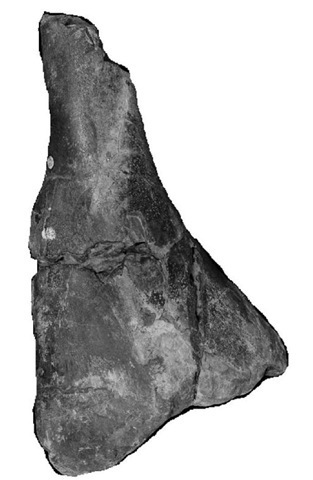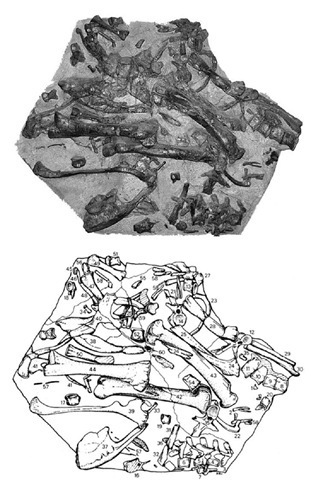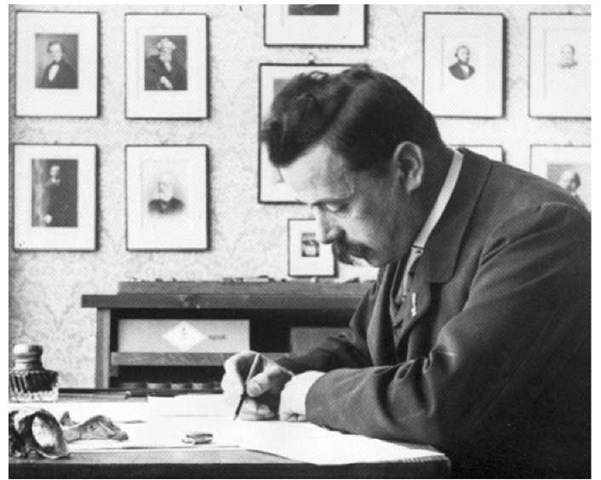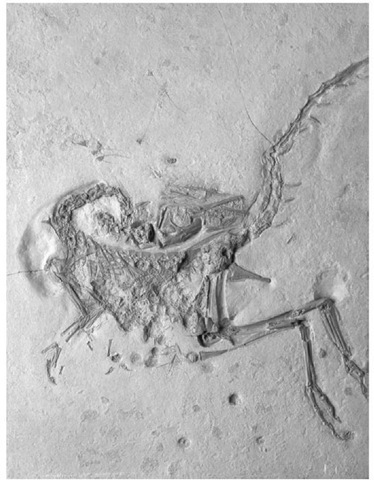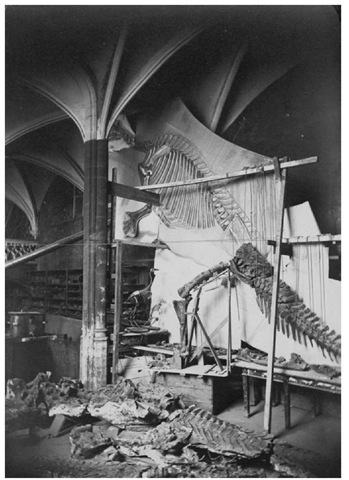Dinosaur discovery: Iguanodon
Once you have found your fossil, it needs to be studied scientifically in order to reveal its identity, its relationship to other known organisms, as well as more detailed aspects of its appearance, biology, and ecology. To illustrate a few of the trials and tribulations inherent in any such programme of palaeontological investigation, we will examine a rather familiar and well-studied dinosaur: Iguanodon. This dinosaur has been chosen because it has an interesting and appropriate story to tell, and one with which I am familiar, because it proved to be the unexpected starting point for my career as a palaeontologist. Serendipity seems to have a significant role to play in palaeontology, and this is certainly true for my own work.
The story of Iguanodon covers almost the entire history of scientific research on dinosaurs and also the entire history of the science now known as palaeontology. As a result, this animal unwittingly illustrates the progress of scientific investigation on dinosaurs (and other areas of palaeontology) during the past 200 years. The story also reveals scientists as human beings, with passions and struggles, and the pervasive influence of pet theories at times in the history of the subject.
The first bonafide records of the fossil bones that were later to be named Iguanodon date back to 1809. They comprise, among indeterminable broken fragments of vertebrae, the lower end of a large, very distinctive tibia (shin bone) collected from a quarry at Cuckfield in Sussex (Figure 6). This particular fossil was collected by William Smith (often referred to as the ‘father of English geology’). Smith was then researching the first geological map of Britain, which he completed in 1815. Although these fossil bones were clearly sufficiently interesting to have been collected and preserved (they are still in the collections of the Natural History Museum, London), no further study was made of them. The bones languished unrecognized until I was asked to establish their identity in the late 1970s.
6. The first Iguanodon bone ever collected, by William Smith at Cuckfield in Sussex, in 1809
Yet 1809 was a remarkably opportune moment for such a discovery to be made. Things were happening in Europe in the branch of science concerned with fossils and their meaning. One of the greatest and most influential scientists of this age, Georges Cuvier (1769-1832), was a ‘naturalist’ working in Paris and an administrator in the Emperor Napoleon’s government. ‘Naturalist’ was, in these times, a broad category denoting the philosopher-scientist who worked on a wide range of subjects associated with the natural world: the Earth, its rocks and minerals, fossils, and all living organisms. In 1808, Cuvier redescribed a renowned gigantic fossil reptile collected from a chalk quarry at Maastricht in Holland; its renown stemmed from the fact that it had been claimed as a trophy of war during the siege of Maastricht in 1795 by Napoleon’s army. The creature, originally mistaken for a crocodile, was identified correctly by Cuvier as an enormous marine lizard (later named Mosasaurus by the English cleric and naturalist the Revd William D. Conybeare). The effect of this revelation – the existence of an unexpectedly gigantic fossil lizard of a former time in Earth history – was truly profound. It encouraged the search for, and discovery of, other giant extinct ‘lizards’; it established, beyond reasonable doubt, that pre-biblical ‘earlier worlds’ had existed; and it also determined a particular way of viewing and interpreting such fossil creatures: as gigantic lizards.
Following the defeat of Napoleon and the restoration of peace between England and France, Cuvier was finally able to visit England in 1817-18 and meet scientists with similar interests. At Oxford he was shown some gigantic fossil bones in the collections of the geologist William Buckland; these seemed to belong to a gigantic, but this time land-living, lizard-like creature, and they reminded Cuvier of similar bones that had been found in Normandy. William Buckland eventually named this creature Megalosaurus in 1824 (with a little help from Conybeare).
However, from the perspective of this particular story, the really important discoveries were not made until around 1821-2 and at the same quarries, around Whiteman’s Green in Cuckfield, visited by William Smith some 13 years earlier. At this time, an energetic and ambitious medical doctor, Gideon Algernon Mantell (1790-1852), living in the town of Lewes, was dedicating all his spare time to completing a detailed report on the geological structure and fossils in his native Weald district (an area incorporating much of Surrey, Sussex, and part of Kent) in southern England. His work culminated in an impressively large, well-illustrated topic that he published in 1822. Included in this topic were clear descriptions of several unusual, large reptilian teeth and ribs that he had been unable to identify properly. Several of these teeth were purchased by Mantell from quarrymen, while others had been collected by his wife, Mary Ann. The next three years saw Mantell struggling to identify the type of animal to which these large fossil teeth might have belonged. Although not trained in comparative anatomy (the particular specialism of Cuvier), he developed contacts with many learned men in England in the hope of gaining some insight into the affinity of his fossils; he also sent some of his precious specimens to Cuvier in Paris for identification. At first, Mantell’s discoveries were dismissed, even by Cuvier, as fragments of Recent animals (perhaps the incisor teeth of a rhinoceros, or those of large, coral-chewing, bony fish). Undeterred, Mantell continued to investigate his problem, and finally found a likely solution. In the collections of the Royal College of Surgeons in London he was shown the skeleton of an iguana, a herbivorous lizard that had recently been discovered in South America. The teeth were similar in general shape to those of his fossils and indicated to Mantell that they belonged to an extinct, herbivorous, giant relative of the living iguana. Mantell published a report on the new discovery in 1825 and the name chosen for this fossil creature was, perhaps not surprisingly, Iguanodon. The name means, quite literally, ‘iguana tooth’ and was created yet again, at the suggestion of Conybeare (clearly the latter’s classical training and turn of mind gave him a natural facility in the naming of many of these early discoveries).
7. One of the original Iguanodon teeth found by the Mantells
Not surprisingly, given the comparisons then available, these early discoveries confirmed the existence of an ancient world inhabited by improbably large lizards. For example, a simple scaling of the minute teeth of the living (metre-long) iguana with those of Mantell’s Iguanodon yielded a body length in excess of 25 metres. The excitement, and personal fame, engendered by the description of Iguanodon drove Mantell to greater efforts to discover more about this animal and the fossil inhabitants of the ancient Weald.
For several years after 1825, only fragments of Weald fossils were discovered; then, in 1834, a partial, disarticulated skeleton (Figure 8) was discovered at a quarry in Maidstone, Kent. Eventually purchased for Mantell, and christened the ‘Mantel-piece’, it proved to be the inspiration behind much of his later work and resulted in some of the first visualizations of dinosaurs ever produced (Figure 9). He continued probing the anatomy and biology of Iguanodon in his later years, but much of this was, alas, overshadowed by the rise of an extremely able, well-connected, ambitious, and ruthless personal nemesis: Richard Owen (1804-1892) (see Figure 1).
The ‘invention’ of dinosaurs
Fourteen years younger than Mantell, Richard Owen also studied medicine, but concentrated in particular on anatomy. He gained a reputation as a skilled anatomist, and acquired a position at the Royal College of Surgeons in London, which gave him access to a great deal of comparative material and, through considerable industry and skill, allowed him to foster a reputation as the ‘English Cuvier’. During the late 1830s, he was able to persuade the British Association to grant him money to prepare a detailed review of all that was then known of British fossil reptiles. This eventually resulted in the publication of a stream of large, well-illustrated volumes that would mimic the hugely important works (notably the multi-volume Ossemens Fossiles) published by Cuvier earlier in the century, and further cemented Owen’s scientific reputation.
8. Photograph and sketch of ‘Mantel-piece’, a partial skeleton discovered in Maidstone, Kent, in 1834
9. Mantell’s sketch reconstructing Iguanodon (c. 1834)
This project resulted in two important publications: one in 1840 on mostly marine fossils (Conybeare’s Enaliosauria) and another in 1842 on the remainder, including Mantell’s Iguanodon. The 1842 report is a remarkable document because of Owen’s invention of the new ‘tribe or sub-order … which I … name … Dinosauria’. Owen identified three dinosaurs in this report: Iguanodon and Hylaeosaurus, both discovered in the Weald and named by Mantell; and Megalosaurus, the giant reptile from Oxford. He recognized dinosaurs as members of a unique and hitherto unrecognized group on the basis of several detailed and distinctive anatomical observations. These included the enlarged sacrum (a remarkably strong attachment of the hips to the spinal column), the double-headed ribs in the chest region, and the pillar-like construction of the legs (see Figure 10).
In reviewing each dinosaur in turn, Owen trimmed their dimensions considerably, suggesting that they were large, but in the region of 9 to 12 metres, rather than the more dramatic lengths suggested by Cuvier, Mantell, and Buckland on previous occasions. Furthermore, Owen speculated a little more on the anatomy and biology of these animals in words that have an extraordinary resonance in the light of today’s interpretations of the biology and way of life of dinosaurs.
10. Owen’s reconstruction of Megalosaurus (c. 1854)
Among his concluding remarks in the report, he observed that dinosaurs:
Attained the greatest bulk, and must have played the most conspicuous parts, in their respective characters as devourers of animals and feeders upon vegetables, that this earth has ever witnessed in oviparous [egg-laying] and cold-blooded creatures.
And also that:
The Dinosaurs having the same thoracic structure as the Crocodile, may be concluded to have possessed a four-chambered heart . . . more nearly approaching that which now characterizes the warmblooded Mammalia.
Owen’s conception was therefore one of very stout, but egg-laying and scaly (because they were still reptiles) creatures resembling the largest mammals to be found in the tropical regions of the Earth today; his dinosaurs were in effect the crowning glory of a time on Earth when egg-laying and scaly-skinned reptiles reigned supreme. Owen’s dinosaurs were the ancient world’s equivalents of present-day elephants, rhinos, and hippos. Looked at purely from the logic of scientific deduction, based on such meagre remains, this was not only brilliantly incisive, but an altogether revolutionary vision of creatures from the ancient past. Such breathtaking vision is all the more remarkable when it is juxtaposed to the ‘gigantic lizard’ models, though these were entirely reasonable and logical interpretations built on established and respected Cuvierian principles of comparative anatomy.
The creation of the Dinosauria had other important purposes at the time. The reports also offered a sweeping refutation of the general progressionist and transmutationist movements within the fields of biology and geology during the first half of the 19th century. Progressionists noted that the fossil record seemed to show that life had become progressively more complex: the earliest rocks showed the simplest forms of life, while more recent rocks showed evidence of more complex creatures. Transmutationists noted that members of one species were not identical and pondered whether this variability might also allow species to change over time. Jean Baptiste de Lamarck, a colleague of Cuvier in Paris, had suggested that animal species might transmute, or change, in form over time through the inheritance of acquired characteristics. These ideas challenged the widely held, biblically inspired belief that God had created all creatures on Earth, and were being widely and acrimoniously discussed.
Dinosaurs, and indeed several of the groups of organisms recognized in the God-fearing Owen’s reports, provided evidence that life on Earth did not demonstrate an increase in complexity over time – in fact quite the reverse. Dinosaurs were anatomically reptiles (that is to say, members of the general group of egg-laying, cold-blooded, scaly vertebrates); however, the reptiles living today were a degenerate group of creatures when compared to Owen’s magnificent dinosaurs that had lived during Mesozoic times. In short, Owen was attempting to strangle the radical, scientifically driven intellectualism of the time in order to re-establish an understanding of the diversity of life that had its basis closer to the views espoused by Reverend William Paley in his topic entitled Natural Theology in which God held centre-stage as the Creator and Architect of all Nature’s creatures.
Owen’s fame grew steadily through the 1840s and 1850s, and he became involved in the committees associated with the planning of the relocated Great Exhibition of 1854. It is a curious fact that Owen, for all his burgeoning fame, was not first choice as the scientific director for the construction of the dinosaurs – Gideon Mantell was. Mantell refused on the grounds of persistent ill-health, and also because he was exceedingly wary of the risks associated with popularizing scientific work, particularly the risk of misrepresentating imperfectly developed ideas.
Mantell’s story ended in tragedy: his obsession with fossils and the development of a personal museum led to the collapse of his medical practice, and his family disintegrated (his wife left him and his surviving children emigrated once they were old enough to leave home). The diary that he kept for much of his life makes melancholy reading; in his final years he was left lonely and racked by chronic back pain, and he died of a self-administered overdose of laudanum.
Although outflanked by the ambitious, brilliant, and crucially full-time, scientist Owen, Mantell spent much of the last decade of his life continuing research on ‘his’ Iguanodon. He produced a series of scientific articles and extremely popular topics summarizing many of his new discoveries, and he was the first to realize (in 1851) that Owen’s vision of the dinosaurs (or at least Iguanodon) as stout ‘elephantine reptiles’ was probably wrong. Further discoveries ofjaws with teeth, and further analysis of the partial skeleton (the ‘Mantel-piece’), revealed that Iguanodon had strong back legs and smaller, weaker front limbs. As a result, he concluded that its posture may have had much more in common with the ‘upright’ reconstructions of giant ground sloths (paradoxically inspired by Owen’s detailed description of the fossil ground sloth Mylodon). Unfortunately, this work was overlooked, largely because of the excitement and publicity surrounding Owen’s Crystal Palace dinosaur models. The truth of Mantell’s suspicions, and the strength of his own intellect, were not to be revealed for a further 30 years, and through another amazing piece of serendipity.
Reconstructing Iguanodon
In 1878 remarkable discoveries were made at a coal mine in the small village of Bernissart in Belgium. The colliers, who were mining a coal seam over 300 metres beneath the surface, suddenly struck a seam of shale (soft, laminated clay) and began to find what appeared to be large pieces of fossil wood; these were eagerly collected because they seemed to be filled with gold! On closer inspection, the wood turned out to be fossil bone, and the gold ‘fool’s gold’ (iron pyrites). A few fossil teeth were also discovered among the bones, and these were identified as similar to those described as belonging to Iguanodon by Mantell many years before. The miners had accidentally discovered not gold, but a veritable treasure trove of complete dinosaur skeletons.
Over the next five years, a team of miners and scientists from the Royal Belgian Museum of Natural History in Brussels (now the Royal Institute of Natural Sciences) excavated nearly 40 skeletons of the dinosaur Iguanodon, as well as a huge number of other animals and plants whose remains were preserved in the same shales. Many of the dinosaur skeletons were complete and fully articulated; they represented the most spectacular discovery that had been made anywhere in the world at the time. It was the good fortune of a young scientist in Brussels, Louis Dollo (1857-1931), to be able to study and describe these extraordinary riches, and this he did from 1882 until his retirement in the 1920s.
11. Louis Dollo (1857-1931)
The complete dinosaur skeletons unearthed in Bernissart proved finally that Owen’s model of dinosaurs such as Iguanodon was incorrect. As Mantell had suspected, the front limbs were not as large and strong as the back legs, while the animal had a massive tail (see Figure 12), and the overall proportions of a giant kangaroo.
The skeletal restoration, and the process by which it was arrived at, are particularly revealing because they show how the influence of the contemporary interpretations about the appearance and affinities of dinosaurs affected Dollo’s work. Owen’s ‘elephantine reptile’ vision of the dinosaur had been questioned as early as 1859 by some tantalizingly incomplete dinosaur discoveries made in New Jersey and studied by Joseph Leidy, a man of equivalent scientific stature to Owen who was based at the Philadelphia Academy of Natural Sciences. However, Owen was to be far more roundly criticized by a younger, London-based, and ambitious rival: Thomas Henry Huxley (1825-95).
12. Drawing of an Iguanodon skeleton
By the late 1860s, a series of new discoveries had been made that added considerably to the debate over the relationships of dinosaurs to other animals. The earliest well-preserved fossil bird (called Archaeopteryx, or ‘ancient wing’) had been discovered in Germany (Figure 13). It was eventually bought from its private collector by the Natural History Museum in London, and described by Richard Owen in 1863. The specimen was unusual in that it had well-preserved impressions of feathers, the key identifier for any bird, forming a halo in the matrix around its skeleton; however, unlike any living bird, and rather disconcertingly similar to modern reptiles, it also had three long fingers ending in sharp claws on each hand, teeth in its jaws, and a long bony tail (some living birds might seem to have long tails, but this is just the profile of their feathers that are anchored in a short remnant of the tail).
Not long after the discovery of Archaeopteryx, another small, well-preserved skeleton was found in the same quarries in Germany (Figure 14). It bore no feather impressions and its arms were far too short to have served as wings in any case; anatomically, it was clearly a small, predatory dinosaur and was named Compsognathus (‘pretty jaw’).
These two discoveries emerged at a particularly sensitive time scientifically speaking. In 1859, just a year or so before the first skeleton of Archaeopteryx was unearthed, Charles Darwin published a topic entitled On the Origin of Species. This topic provided a very detailed discussion of the evidence in favour of the ideas being put forward by the transmutationists and progressionists referred to earlier.
13. A well preserved Archaeopteryx specimen, discovered in 1876 (approx 40 cm long)
Most importantly, Darwin suggested a mechanism – natural selection – by which such transmutations might occur and how new species appear on Earth. The topic was sensational at the time because it offered a direct challenge to the almost universally accepted authority of biblical teachings by suggesting that God did not directly create all the species known in the world. Darwin’s ideas were vigorously opposed by pious establishment figures such as Richard Owen. In contrast, the radical intellectuals reacted very positively to Darwin’s ideas. Thomas Huxley is reputed to have declared, after reading Darwin’s topic, ‘How very stupid of me not to have thought of that!’
14. Compsognathus skeleton (approx 70 cm long)
While not wishing to become too involved in Darwinian matters, it is nevertheless the case that dinosaurian discoveries featured in some of the arguments. Huxley was quick to realize that Archaeopteryx and the small predatory dinosaur Compsognathus were anatomically very similar. By the early 1870s, Huxley was proposing that birds and dinosaurs were not only anatomically similar, but used this evidence to support the theory that birds had evolved from dinosaurs. In many ways, the stage was set for the discoveries in Belgium. By the late 1870s, Louis Dollo, as a bright young student, would have been fully aware of the Owen-Huxley/ Darwin feuds. One burning question must have been: did these new discoveries have any bearing on the great scientific controversy of the day?
Careful anatomical study of the full skeleton of Iguanodon revealed that it had a hip structure known as ornithischian (‘bird-hipped’); furthermore, it had long back legs that ended in massive, but decidedly bird-like, three-toed feet (very similar in shape to the feet of some of the biggest known land-living birds such as emus). This dinosaur also had a rather bird-like curved neck, and the tips of its upper and lower jaws were toothless and covered by, yet again, a bird-like horny beak or bill. Given the task of description and interpretation faced by Dollo in the immediate aftermath of these exciting discoveries, it is intriguing to note that, in the early photographs taken at the time of the reconstruction of the first skeleton in Brussels, just beside the huge dinosaur skeleton can be seen skeletons of two Australian creatures: a wallaby (a small variety of kangaroo) and a large, flightless bird known as a cassowary.
The influence of the debate raging in England cannot be doubted. This new discovery pointed to the truth implicit in Huxley’s arguments and made it clear that Mantell had been on the right track in 1851. Iguanodon was no lumbering, scaly rhinoceros lookalike as portrayed by Owen in his grand models of 1854; rather it was a huge creature with a pose similar to that of a resting kangaroo, but with a number of bird-like attributes, just as Huxley’s theory predicted.
15. Iguanodon being reconstructed at the Museum of Natural History, Brussels, in 1878. Note the cassowary and wallaby skeletons used for comparison.
Dollo proved to be tirelessly inventive in his approach to the fossil creatures that he described – he dissected crocodiles and birds in order to better understand the biology and detailed musculature of these animals and how it could be used to identify the soft tissues of his dinosaurs. In many respects, he was adopting a decidedly forensic approach to understanding those mysterious fossils. Dollo was regarded as the architect of a new style of palaeontology that became known as palaeobiology. Dollo demonstrated that palaeontology should be expanded to investigate the biology, and by implication ecology and behaviour, of these extinct creatures. His final contribution to the Iguanodon story was a paper he published in 1923 to honour the centenary of Mantell’s original discoveries. He succinctly summarized his views on the dinosaur, identifying it as the dinosaurian ecological equivalent of the giraffe (or indeed Mantell’s giant ground sloth). Dollo concluded that its posture enabled it to reach high into trees to gather its fodder, which it was able to draw into its mouth by using a long, muscular tongue; the sharp beak was used to nip off tough stems, while the characteristic teeth served to pulp the food before it was swallowed. So firmly was this authoritative interpretation adopted, based as it was on a set of complete articulated skeletons, that it stood, literally and metaphorically, unchallenged for the next 60 years. This was reinforced by the distribution of replica, mounted skeletons of Iguanodon from Brussels to many of the great museums around the world during the early years of the 20th century.
